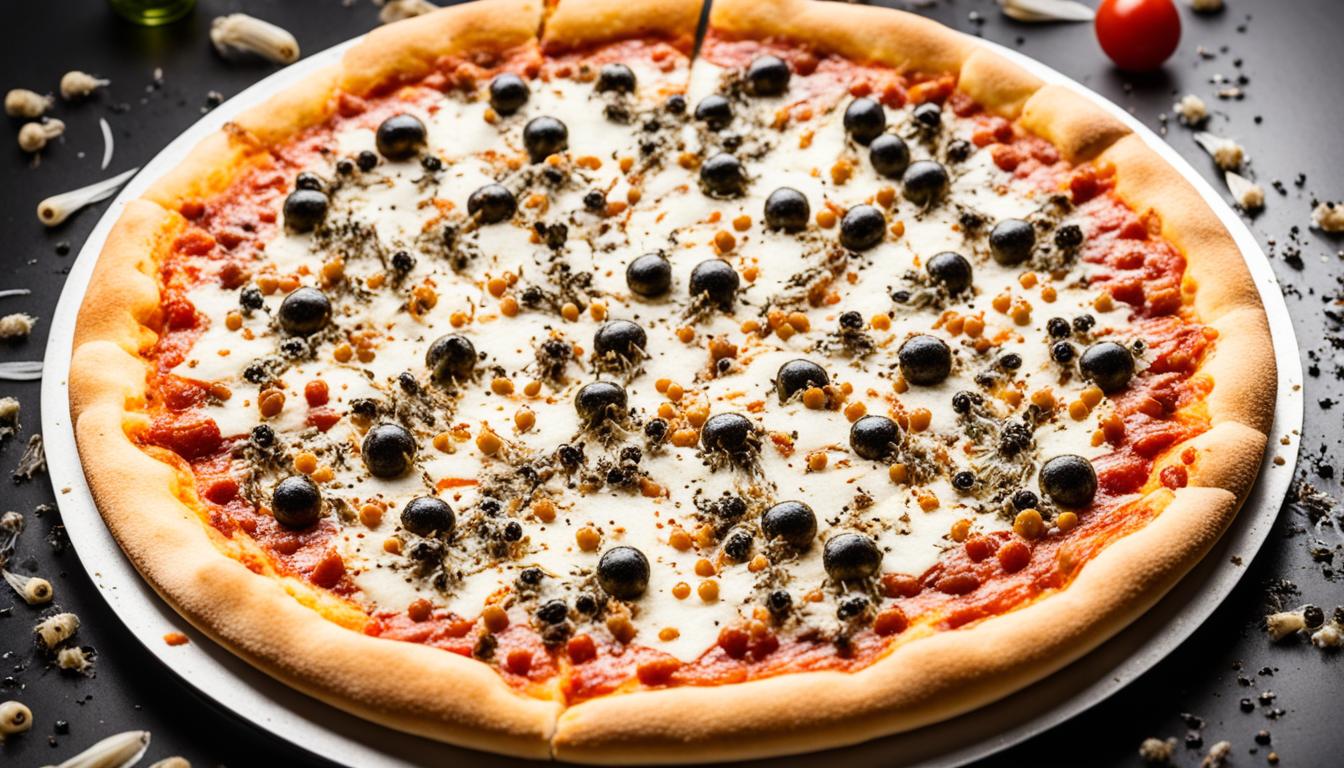Many of us love eating pizza. But, did you know that not handling or cooking it right can cause food poisoning? Understanding the risks and steps to avoid getting sick is key.
Key Takeaways:
- Leaving pizza at room temperature for more than two hours can increase the risk of food poisoning.
- Bacteria can rapidly grow on pizza when it’s in the “danger zone” between 40°F and 140°F.
- Symptoms of food poisoning from pizza may include gastrointestinal issues, fever, and more.
- Preventing food poisoning from pizza involves proper storage, cooking, and handling practices.
- It’s important to seek medical attention for severe symptoms that last more than 24 hours.
Understanding the Risks of Pizza Consumption
Pizza is a popular and delicious dish. However, it’s important to know the risks of food poisoning from eating it. Various factors contribute to the risk of getting sick from pizza.
Raw or half-cooked meats, like sausage and pepperoni, can have harmful bacteria. Salmonella and E. coli from these meats can make you very sick.
Contaminated vegetables and fruits on pizza can also cause illness. It’s key to wash and handle all toppings well to avoid getting sick.
Cheese that isn’t stored right can also cause problems. If cheese isn’t kept at the right temperature, harmful bacteria can grow.
Cross-contamination is a common issue when making pizza. Bacteria from raw meat can spread to other ingredients or areas. It’s critical to use separate tools for raw meats to stop this.
Pizza can also have downsides like being high in calories and sodium. This is due to processed meats and high-fat cheese. It might also not have enough vegetables, making it less healthy.
People with acid reflux or gluten sensitivity might have problems after eating pizza. Those with dietary needs should think carefully before eating pizza.
Risks of Pizza Consumption
| Risks | Effects |
|---|---|
| Raw or half-cooked meats | Salmonella and E. coli contamination |
| Contaminated vegetables and fruits | Bacterial infections |
| Improper storage of cheese | Bacterial growth and foodborne illness |
| Cross-contamination | Spread of bacteria from raw meats to other ingredients |
| High calorie and sodium content | Potential health effects |
| Low nutritional value without vegetables | Lack of essential nutrients |
Even with these risks, you can still safely enjoy pizza. Just handle food safely, choose ingredients wisely, and eat it in moderation.
Recognizing and Preventing Food Poisoning Symptoms
Stomach cramps, pain, diarrhea, and vomiting can be food poisoning signs from pizza. You might also have a fever. These can show up minutes to weeks after eating. It often feels like the flu. Most food poisoning gets better by itself. But, seek medical help if it’s bad or lasts more than a day. Kids, pregnant women, older adults, and those with weak immune systems must get help right away if they think it’s food poisoning.
Common Symptoms of Food Poisoning from Pizza
- Cramping: Abdominal discomfort or pain.
- Stomach pain: Aching or sharp pains in the stomach area.
- Diarrhea: Frequent loose or watery bowel movements.
- Nausea: Feeling sick in the stomach, with a want to vomit.
- Vomiting: Throwing up forcefully.
- Fever: High body heat, showing your body is fighting an infection.
“If you experience severe symptoms or if they persist for more than 24 hours, it is crucial to seek medical attention immediately. Don’t ignore the signs and protect your health.”
Certain people, like kids, pregnant women, older adults, and those with weak immune systems, face greater risks from food poisoning. They need to be very careful and see a doctor fast if they suspect food poisoning from pizza.
Treatment for Food Poisoning from Pizza
Often, food poisoning from pizza gets better on its own. But, you should take steps to help recovery and ease symptoms:
- Hydrate: Drink lots of liquids to make up for fluids lost from vomiting and diarrhea.
- Rest: Taking it easy helps your body heal.
- Medication: Some medicines can ease cramps, stomach pain, and nausea. But always ask a doctor before using them, especially for certain groups like kids, pregnant women, and people with health issues.
Seeing a doctor is key if symptoms are severe, last over a day, or if you worry about dehydration or complications. A doctor can give you the right diagnosis and suggest the best treatment.
Tips for Preventing Food Poisoning from Pizza
To lower the chance of getting sick from pizza, you should take some steps. Here’s how to eat pizza without worry:
- Choose reputable pizza sources: Order from pizzerias known for care in food safety. Pick places well-reviewed for their cleanliness.
- Ensure safe food handling during delivery: Make sure your pizza arrives hot and well-packed. The delivery person should use clean containers and keep the pizza warm.
- Avoid leaving pizza at room temperature: Don’t leave pizza out for more than two hours. If it’s over 90°F, one hour is the max. Dangerous bacteria grow fast in warm temperatures. Put any leftover pizza in the fridge quickly.
- Reheat leftovers to the right temperature: Heat your pizza until it’s 165°F inside to destroy bacteria. Use an oven or microwave for thorough warming. A food thermometer will confirm the right temperature.
- Store leftover pizza properly: Cool and pack your leftover pizza within two hours. Use an airtight container or plastic wrap to keep it fresh and safe. Eat it within three to four days.
- Practice good hygiene: Always wash your hands before and after touching pizza. For raw and cooked foods, use different utensils and boards. Make sure everything used in making pizza is cleaned and sanitized.
By being mindful of these tips, you can enjoy pizza without the fear of food poisoning.
Food Safety Guidelines for Pizza Restaurants
Keeping customers safe from food poisoning is a must for pizza restaurants. They should stick to these important safety rules:
- Compliance with health regulations: Pizza places need regular checks to meet health and safety standards. Proper food handling and preparation are key.
- Employee education on food safety: Training staff on how to handle food safely is crucial. They should know how to wash hands correctly, manage food, and avoid cross-contamination.
- Proper food storage: Pizza restaurants must keep their ingredients fresh and safe. This means refrigerating perishables correctly to stop bacteria from growing.
Following these steps helps ensure a safe dining experience for pizza lovers.
Treatment for Pizza-Induced Food Poisoning
Food poisoning from pizza usually gets better by itself. But, seek medical help if symptoms are bad or don’t go away after 24 hours. This is very important for children, pregnant women, older adults, and anyone with a weak immune system.
Treatment includes staying hydrated, resting, and possibly using medicines for pain, diarrhea, or vomiting. Always talk to a doctor to get the right advice for your situation.
Consulting a Healthcare Professional
If you think pizza has made you sick, see a doctor for the right diagnosis and treatment plan. They can figure out your symptoms, suggest medicine if needed, and help you recover the right way.
“Seeking medical attention is vital for individuals with severe symptoms or those belonging to vulnerable groups who may require closer monitoring and specific interventions.” – Dr. Emily Williams, MD
Don’t try to treat it yourself or ignore ongoing symptoms. Getting professional help means you’re taking care of your health.
| Treatment for Food Poisoning from Pizza | Details |
|---|---|
| Hydration | Drinking plenty of fluids, especially water and electrolyte-rich solutions, to prevent dehydration caused by vomiting and diarrhea. |
| Rest | Taking time to rest and recuperate to allow your body to heal and recover from the food poisoning. |
| Medication | Over-the-counter medications such as anti-diarrheal, antiemetics (to control nausea and vomiting), and antacids (to alleviate stomach pain and discomfort). |
| Consultation with a healthcare professional | Seeking medical attention for proper diagnosis, individualized treatment, and guidance throughout the recovery process. |
Each person’s experience with food poisoning is different. Your doctor’s treatment plan will depend on your symptoms, health, and medical history. Always listen to their advice and contact them if you’re worried while recovering.
The Importance of Safe Handling and Storage of Pizza
Handling and storing pizza right is key to avoid food poisoning. By following simple steps, you can keep your pizza safe and fresh:
1. Store leftovers properly: Keep leftover pizza in an airtight container or wrap it well before putting it in the fridge. This stops outside germs and keeps the pizza good.
2. Refrigerate within two hours: Put leftover pizza in the fridge within two hours after it’s made or arrives. This action slows down germs and lowers food poisoning risk.
3. Thaw in the refrigerator: Thaw frozen pizza in the fridge, not on the counter. This stops bad bacteria from growing.
4. Reheat to the right temperature: When warming up pizza, heat it until it’s 165°F inside. This temperature kills bacteria, making it safer to eat.
5. Prevent cross-contamination: Avoid bacteria spread by using different boards and tools for raw and cooked food. Always wash your hands after touching raw meat or ingredients.
6. Maintain a clean kitchen environment: A tidy kitchen helps stop germs and keeps food safe. Clean all areas, tools, and surfaces that touch pizza ingredients well.
Safe pizza handling and storing let you enjoy your meal without risking your health. Let’s make our pizzas both tasty and safe!
Understanding the Risks of Expired Pizza
Eating expired pizza can lead to foodborne illness. This happens when toppings like cheese and sauce go bad. These spoiled ingredients are perfect for harmful bacteria to grow.
Consuming expired pizza can let these bacteria enter your body, causing food poisoning. To avoid this, always check the expiration dates on pizza ingredients. Throw away any pizza that’s beyond its safe eating date.
Understanding the risks and practicing food safety helps avoid food poisoning. Always watch expiration dates and don’t eat expired food to protect your health.
Expired Pizza and Foodborne Illness
Expired pizza might contain harmful bacteria like Salmonella and E. coli. These can cause stomach pain, diarrhea, nausea, and vomiting. Symptoms can be serious and last a long time, causing discomfort and sometimes leading to doctor visits.
It’s important to know that eating expired pizza raises your risk of getting sick from these bacteria.
Practicing Food Safety to Minimize Risks
To lessen the risk of getting sick from expired pizza, follow food safety steps:
- Check the expiration dates of all pizza ingredients before using them.
- Throw away any pizza that has passed its expiration date.
- Store pizza ingredients correctly to avoid spoilage and bacterial growth.
- Put leftover pizza in the fridge within two hours.
- Eat leftover pizza within three to four days.
- Always reheat leftover pizza to a temperature of 165°F to ensure it’s safe to eat.
By sticking to these food safety tips, you can enjoy pizza without worrying about the risks of eating expired pizza.
Ensuring Food Safety in Pizza Restaurants
Pizza restaurants have a key role in keeping customers safe. They follow food safety rules closely. This helps stop food poisoning and ensures a safe place to eat for everyone.
Consistent Inspections: It’s vital for pizza places to have regular checks. These checks make sure they meet health standards. They look at how food is handled, the cleanliness, and how ingredients are stored. High hygiene and safety standards show they care about serving safe food.
Thorough Personnel Education: Trained staff are essential in a pizza restaurant. Workers learn about food safety, like washing hands right, avoiding cross-contamination, and keeping food at safe temperatures. It’s important to keep teaching staff to keep the restaurant safe.
Proper Food Storage: How ingredients are stored is very important. It stops bacteria from growing and reduces illness risks. Pizza places need to keep things like meats, cheese, and veggies at the right temperatures and in clean conditions. Following strict rules on how ingredients are handled keeps the pizzas safe and tasty.
Putting food safety first helps pizza restaurants build trust with customers. Being committed to safety helps protect customers’ health. It also builds a good reputation and helps the business do well.
Quotes:
“Following food safety guidelines isn’t just a legal requirement for pizza restaurants; it’s a responsibility to ensure the well-being of our customers.” – Donato’s Pizza Manager
“We invest heavily in educating our staff about food safety practices. It’s our commitment to providing a safe and enjoyable dining experience for everyone who walks through our doors.” – Tony’s Pizza Owner
| Food Safety Guidelines for Pizza Restaurants |
|---|
| 1. Conduct regular inspections to ensure compliance with health regulations. |
| 2. Provide comprehensive food safety training for all personnel. |
| 3. Implement proper food storage procedures for perishable ingredients. |
| 4. Practice good hygiene, including frequent handwashing and equipment sanitization. |
| 5. Prevent cross-contamination by separating raw and cooked ingredients. |
| 6. Monitor and maintain proper temperatures for storage, cooking, and holding of food. |
| 7. Keep accurate records of food safety practices and inspections. |
| 8. Stay up-to-date with the latest food safety regulations and industry best practices. |
Conclusion
Pizza is a great treat, but we must remember food safety to avoid food poisoning. Make sure to handle, cook, and store your pizza right. This way, you can enjoy your favorite meal without the worry of getting sick.
Always put leftovers in the fridge quickly. Also, reheat to the right temperature. Be careful to keep things clean and avoid mixing foods during prep.
Know the signs of food poisoning and get help if you need it. If you or someone you know gets very sick after eating pizza, see a doctor right away.
By sticking to these food safety tips, pizza fans can eat their favorite slices safely. Enjoy your pizza and make sure to stay safe!





